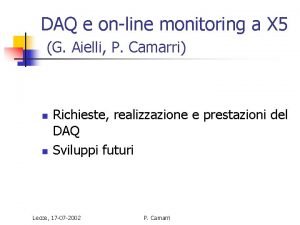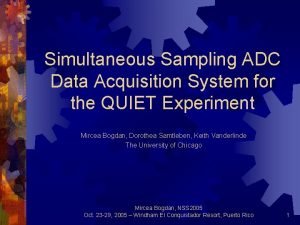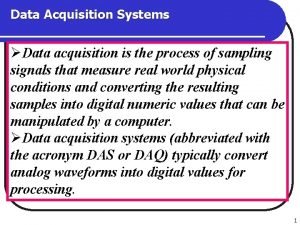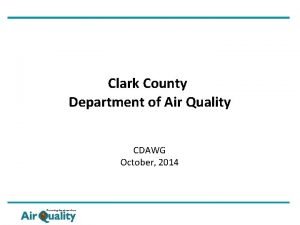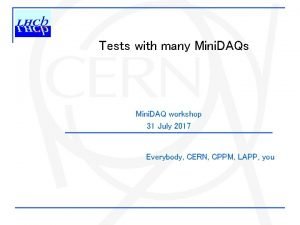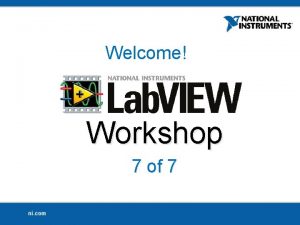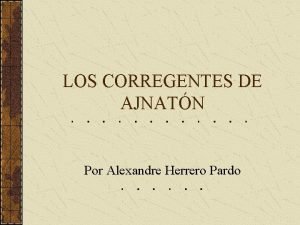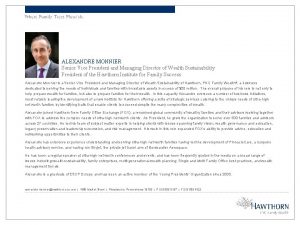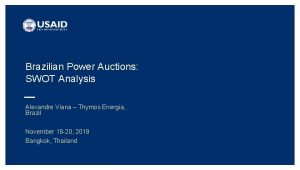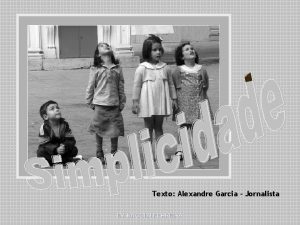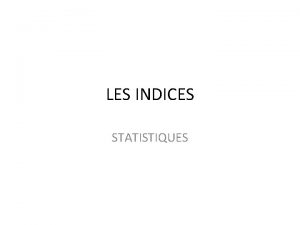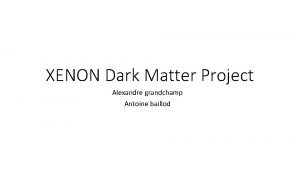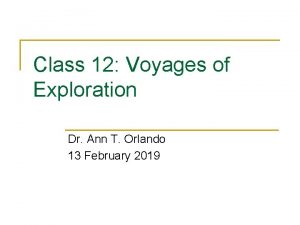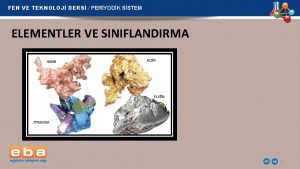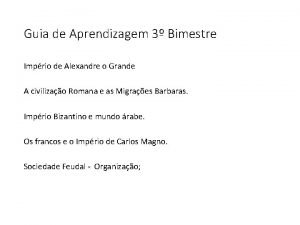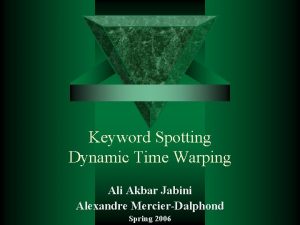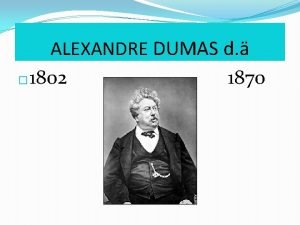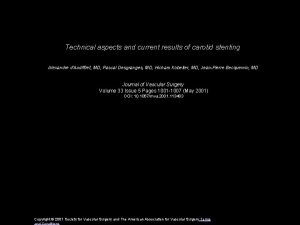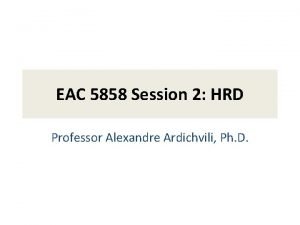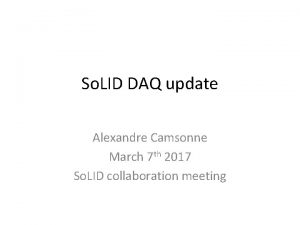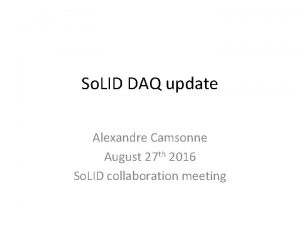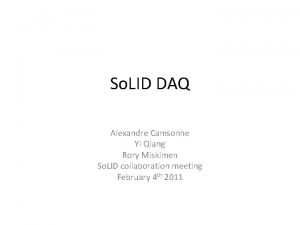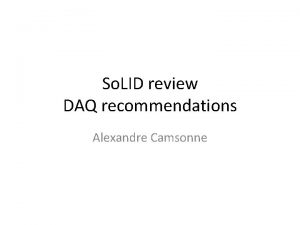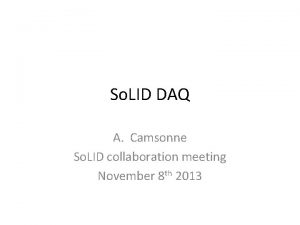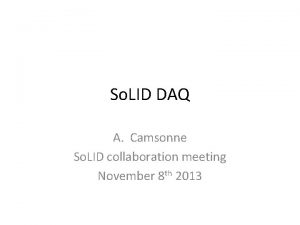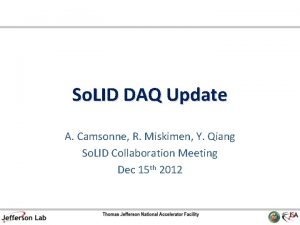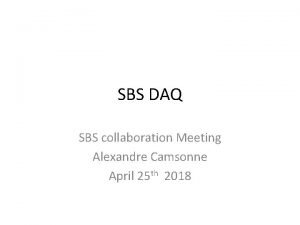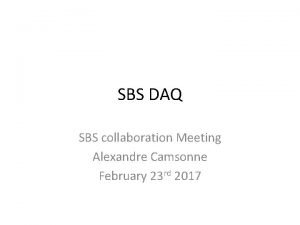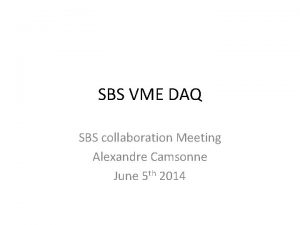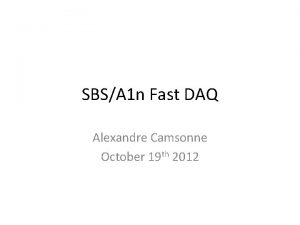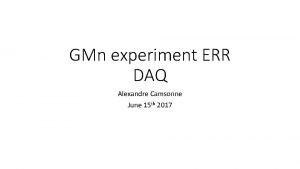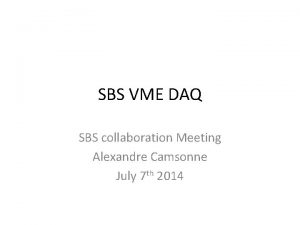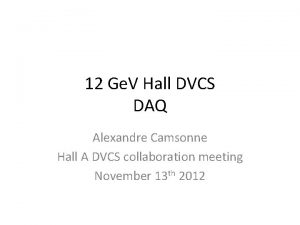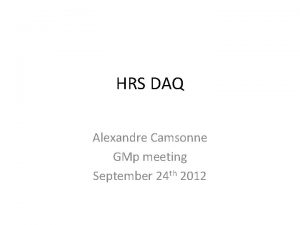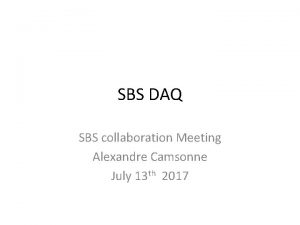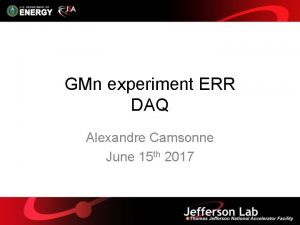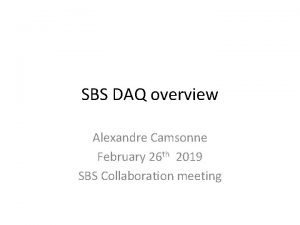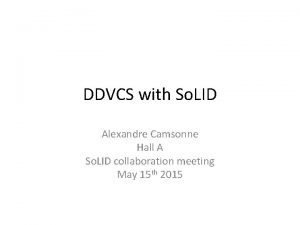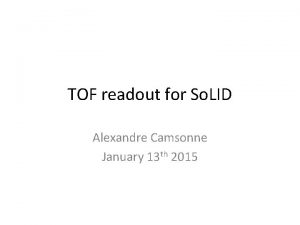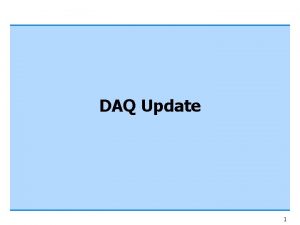So LID DAQ update Alexandre Camsonne So LID






































- Slides: 38

So. LID DAQ update Alexandre Camsonne So. LID Collaboration meeting December 3 th 2016

Overview • • • Recommendations for Director’s review Hardware available Document Updated trigger rates New FADC readout PVDIS deadtime SIDIS event size and data rates Cerenkov readout TOF readout options Simulations needs L 3 farm

Dead time correction PVDIS 1 b. 2 • Test with small scale setup ( Compton ) • Simulation • Discuss with DAQ group for particular features needed • Example : helicity gated deadtimes • Rework CDR to add parity specific electronics • Need to write a separate document about DAQ requirements for DAQ group, Electronics group and potential collaborators on electronics (Saclay)

Dead time correction PVDIS 1 b. 2





Dead time correction PVDIS 1 b. 2


FADC deadtime measurement Do we need to improve it ? Around 0. 3 % deadtime at 20 KHz R&D possible

Measured asymmetry

Dead time modelling • Still need to put together full system / program FPGA • First approximation : fixed dead time 150 ns for each trigger • Expected deadtime : 20 KHz * 150 e-9 = 0. 3 % • Accuracy of measurement 10 % level typical • Correction 0. 03 % error sastify PVDIS requirements • Simulation similar to PVDIS ( need to modify )

6 Ge. V PVDIS Narrow width 30 ns Wide width 100 ns Replace discriminator by Trigger Supervirsor 150 ns width

Results for 6 Ge. V experiment 600 KHz , 50 ns width

DAQ observations

Recommendations 2 c 1. a)The plans for the High Level Trigger and b) the needs for slow control (Brad) need to be worked out in detail and the implications for resources need to be evaluated. 2. The implications of the need for these resources in the context of availability of resources at the laboratory need to be understood. 3. Closer communication with the other JLab experiments and the JLab computing center is strongly encouraged. 4. Having a functional simulation and reconstruction routines as soon as possible should be a high priority in the software effort. Such software will pay off many times over in experimental design and avoiding pitfalls. ( Ole )

Data flow 100 Mb/s VME CPU VME digitizer APV 25 GEM Gig. E CODA Event builder Event recorder SAS RAID Data file ECAL Cerenkov Digital Sum FADC 10/13/2011 VME CPU Super. Bigbite DAQ and Electronics Alexandre Camsonne Compression + 10 Gig. E Silo 18

PVDIS electron trigger • Coincidence ECAL and Gas Cerenkov Old Hall D 290 KHz 230 KHz 1. 9 MHz 803 KHz 16. 5 KHz 4. 1 KHz DIS electron 10 KHz max 7. 7 KHz Total rate 27 KHz 12. 1 KHz Singles ECAL Singles rates Cerenkov Accidental 30 ns 7/9/2014 So. LID DAQ 19

SIDIS_He 3 trigger rate summary • Single e 116+46=162 k. Hz • Random coin 97 k. Hz • True coin rate <70 k. Hz All three true coin rate has overlaps but can’t know how much without a complete generator! • electron trigger self coin 6 k. Hz • coin from SIDIS 36 k. Hz • coin from hadrons 28 k. Hz (still missing window) Total coin rate 167 k. Hz + from hadrons of windows 20

hall. D generator, SIDIS generator & Jin’s EC Wiser trigger JPsi_LH 2 e_FA(k. Hz) EC EC+LGC+SPD electron 355 321 300 Pim 588 10. 2 9. 4 Pip 674 8. 5 7. 5 P 207 0 0 Pi 0 1762 48 26. 4 all hadrons, no electron 3690 81 56 Total: Coincidence trigger searches through all possible candidates (N) and find pairs N*(N-1)/2 Self Coin prescaled by 100 (356+433)/100=8 k. Hz 356 e_LA(k. Hz) EC EC+SPD electron 21 Pim hit matching e_FA e_LA 19 Coin trigger rate (k. Hz) (e_FA + e_LA) & (e_FA + e_LA) 117 106 e+pip 250 24 5 Pip 179 164 e+pim 185 18 3. 5 P 123 114 e+pi 0 217 19. 5 3. 6 Pi 0 306 11 e+p 120 13 1. 8 all hadrons, no electron 814 414 all hadrons, no electron 56 414 0. 3 433 Total: Random coin (356+433)*1 e 3*30 e-9=19 KHz 14. 2 True coin 14. 2 k. Hz Total 2152 k. Hz

SIDIS event size Occupancies with one sample readout by Weizhi , rates for 100 KHz GEM Occupancy Number of strips XY strips Strips per chambers Event size ( Data rate 100 bytes ) KHz 1 2. 21 453 906 27180 2402. 712 240271200 240. 2712 2 8. 78 510 1020 30600 10746. 72 1074672000 1074. 672 3 3. 63 583 1166 34980 5079. 096 507909600 507. 9096 4 2. 31 702 1404 42120 3891. 888 389188800 389. 1888 5 1. 78 520 1040 31200 2221. 44 222144000 222. 144 6 1. 3 640 1280 38400 1996. 8 199680000 199. 68 Total 20. 01 3408 6816 204480 26338. 656 2633865600 2633. 8656 MB/s GEM dominating ( 35 bigger than initial proposal ) 2. 6 GB/s same requirement as PVDIS for L 3 Need to look at FADC occupancies

J/Psi event size ( preliminary ) Occupancies with one sample readout by Weizhi , rates for 50 KHz 50000 KHz Strip Total strips MPDs Hits strip detectors 1 11. 7 453 13590 6. 635742188 106. 002 3180. 06 700. 6069688 70. 06069688 2 22. 8 510 15300 7. 470703125 232. 56 6976. 8 1537. 07625 3 15. 3 583 17490 8. 540039063 178. 398 5351. 94 1179. 099281 117. 9099281 4 12. 7 702 21060 10. 28320313 178. 308 5349. 24 1178. 504438 117. 8504438 5 6 13 10. 8 520 640 15600 19200 7. 6171875 9. 375 135. 2 138. 24 4056 4147. 2 893. 5875 913. 68 Total 86. 3 3408 102240 49. 921875 968. 708 29061. 24 6402. 554438 Rate MB/s Rate per MPD GEM 153. 707625 89. 35875 91. 368

J/Psi event size deconvoluted Occupancies with 3 sample readout by Weizhi , rates for 50 KHz J/psi deco 50000 Strip Total strips MPDs Hits strip detectors Rate MB/s Rate per MPD 1 2. 4 453 13590 6. 635742188 21. 744 652. 32 431. 14275 43. 114275 2 5. 1 510 15300 7. 470703125 52. 02 1560. 6 3 3. 2 583 17490 8. 540039063 37. 312 1119. 36 739. 827 73. 9827 4 2. 6 702 21060 10. 28320313 36. 504 1095. 12 723. 805875 72. 3805875 5 2. 6 520 15600 7. 6171875 27. 04 811. 2 536. 1525 53. 61525 6 2. 1 640 19200 9. 375 26. 88 806. 4 532. 98 53. 298 Total 18 3408 102240 49. 921875 201. 5 6045 3995. 367188 GEM Weiszhi GEM 1031. 459063 103. 1459063

PVDIS GEM event size ( Ole’s occupancy ) PVDIS Total strips Sector Rate 0 1 2 3 4 Total hits / sector Data rate ( sector Mb/s) 0 20000 X Y XY Bytes 3 samples 81. 7 73. 3 68. 3 56. 4 54. 5 88. 3 75. 6 72. 5 58. 2 56. 9 170 148. 9 140. 8 114. 6 111. 4 680 595. 6 563. 2 458. 4 445. 6 2040 1786. 8 1689. 6 1375. 2 1336. 8 574. 3 2742. 8 8228. 4 10971. 2 32913. 6 54856000 164568000 54. 856 164. 568

L 3 farm (2 c 1) • Have digitized data for GEM for SIDIS and PVDIS • Weizhi has tracking algorithm take 2 to 10 ms to process one event so about 1000 nodes for 100 KHz • Need : • • Other include detector data Additionnal reduction algorithm Implement tracking Test on Hall D or DAQ cluster • Discussion with HPC/IT • Current 5000 cores • Upgrade to 10000 cores ( 170 $ per cores currently ) • Seems reasonable to expect 20000 cores by 2023 ( operation upgrade )

L 3 trigger (2 c 1) • 2. 5 to 10 ms for tracking using Kalman Filter ( preliminary ) • PVDIS : 20 KHz 200 cores per sector 6000 cores total • SIDIS • 20 ms • 4000 cores for 200 KHz

L 3 trigger (2 c 1) • Discussed with HPC and IT • Network upgrade : • Current : 2 x 10 Gbit /s = 2 * 1. 2 GB/s from counting house to Computer center • Can be upgrade to 2 x 40 Gbit/s = 10 GB/s when cost go down ( ~5 years ) • Tape SILO TS 3500 • 16 drives : • 6 LTO 6 200 MB/sx 6 + LTO 7 300 MB/sx 8 = 3. 6 GB/s • LTO 7 300 MB/s x 16 -> 4. 8 GB/s • LTO 8 472 MB/sx 16 -> 7. 5 GB/s • Could add second library (150 K$ and each drive 28 K$ ) • L 3 could be located in CC and dynamically allocated ( free ! ) • Need to let IT know the requirements, could invest yearly, need about 2000 today cores

LTO timeline Bottomline : 3 GB/s is reasonable by 2020, L 3 farm optional

Tape costs (2 c 2) Days Data rate Seconds Total data TB Double LTO 5 in $ LTO 6 in $ 2010 2012 LTO 7 in $ 2015 LTO 8 in $ 2018 LTO 9 in $ 2020 LTO 10 in $ 2023 E 12 -11 -108 Pol proton 120 250 10368000 2592 5184 259200 155520 62208 30375 15552 8100 E 12 -12 -006 J/Psi 60 250 5184000 1296 2592 129600 77760 31104 15187. 5 7776 4050 E 12 -10 -006 Transv. Pol. 3 He 90 250 7776000 1944 3888 194400 116640 46656 22781. 25 11664 6075 E 12 -11 -007 Long. Pol. 3 He 35 250 3024000 756 1512 75600 45360 18144 8859. 375 4536 2362. 5 E 12 -10 -007 PVDIS 169 250 14601600 3650. 4 7300. 8 365040 219024 87609. 6 42778. 125 21902. 4 11407. 5 Total 474 40953600 10238. 4 20476. 8 1023840 614304 245721. 6 119981. 25 61430. 4 31995 Per year 394200 236520 94608 46195. 3125 23652 12318. 75 Actual days Actual years 948 2. 60 Time in s 474 40953600 About 17 K$ per PB, 11 K$ per PB for tapes about 250 K$ for 20 PB Cynthia would like about 70 K$ per year in tape ( 50 K$ per year at 250 MB/s), but 300 K$ is not unreasonable if planned in advance Numbers don’t include compression ( additionnal factor of 2 ) Expected to go down by a factor 5 by 2020

Updated realistic ( not crazy) data rates 2010 Days Data rate Seconds 2012 2015 2018 2020 2023 DLO 7 in $ DLO 8 in $ LTO 9 LTO 10 186624 74649. 6 36450 18662. 4 9720 Total Doubl DLO 5 in $ DLO 6 in $ data TB e E 12 -11 -108 Pol proton 120 300 103680 6220. 3110. 4 311040 00 8 E 12 -12 -006 J/Psi 60 3000 518400 0 15552 31104 1555200 933120 373248 182250 93312 48600 E 12 -10 -006 Transv. Pol. 3 He 90 3000 777600 0 23328 46656 2332800 1399680 559872 273375 139968 72900 E 12 -11 -007 Long. Pol. 3 He 35 3000 302400 0 9072 217728 106312. 5 54432 28350 E 12 -10 -007 PVDIS 169 3000 146016 87609. 43804. 8 4380480 2628288 00 6 1051315. 2 513337. 5 262828. 8 136890 Total 474 409536 18973 94867. 2 9486720 5692032 00 4. 4 2276812. 8 1111725 569203. 2 296460 Actual days Actual years 948 2. 60 Time in s 474 18144 907200 544320 Per 3652587. 2191552. 876620. 962 428037. 5791 219155. 2405 114143. 3544 year 342 405 4095360 0 300 K$ of tape over 3 years

Simulations needs • GEM occupancies and digitization SIDIS for event size, occupancy and tracking (Ole, Zhiwen, Weizhi Duke ) • Updated trigger rates PVDIS, SIDIS(Zhiwen, Rakitah) • FADC digitization PVDIS : realistic PID (? ) • Cerenkov simulation only timing readout no FADC(? ) • Effect 1 sample vs 3 samples GEM (Weizhi ) and 20 samples vs time integral SIDIS (? ) • Full FADC trigger simulation • MRPC simulation : response to background

Communication with other groups 2 c 3 • Try collaborate with Hall D • Constant communication with JLAB DAQ and electronics group • Hall C, SBS interested in using VETROC for logic and readout • check experience with APV and FADC from HPS and PRAD • Already planning to reuse HPS trigger scheme

Recommendations 2 c 1. a)The plans for the High Level Trigger and b) the needs for slow control (see Brad’s talk) need to be worked out in detail and the implications for resources need to be evaluated. 2. The implications of the need for these resources in the context of availability of resources at the laboratory need to be understood. Counting house network expected to be 10 GB/s Assuming progresses : around 100 K$ / year for tape at 3 GB/s CPU requirements about 5000 cores : can be absorbed 3. Closer communication with the other JLab experiments and the JLab computing center is strongly encouraged. DAQ, Fast electronics, Hall D 4. Having a functional simulation and reconstruction routines as soon as possible should be a high priority in the software effort. Such software will pay off many times over in experimental design and avoiding pitfalls. ( Ole’s talk )

On going work • SBS • • MPD optical readout SSP data reduction HCAL FADC trigger with VTP readout • Compton • Systematic on dead time correction • So. LID ( when pre. RD ) • Test stand • Trigger programming and simulation

Plan • Compton deadtime measurement setup ( 3 months ) • High statistics to measure ppm level asymmetry • Improve deadtime measurement ( dead time from scaler ) • So. LID trigger implementation ( electronics groups when done with SBS ~ March ) • Test stand if pre. RD ( SBS can give preliminary results )

Short term plan On going work • SBS • MPD optical readout 3 months March 2017 (Ben Raydo, Alexandre Camsonne, UVA, INFN) • SSP data reduction 6 months to 1 year September 2017 (Ben Raydo, Alexandre Camsonne, UVA, INFN) • HCAL FADC trigger with VTP 6 months Mid 2017 ( Ben Raydo, Alexandre Camsonne) • VTP readout 6 months Mid 2017 ( Ben Raydo, Bryan Moffit ) • Deadtime studies, readout optimization ( Bob Michaels ) • Compton • Systematic on dead time correction ( Bob Michaels, ? Lost students ) • So. LID ( when pre. RD ) • Test stand • Trigger programming and simulation

Conclusion • New results from Simulation • PVDIS rate lower 12 KHz, not an issue • SIDIS : • 1 sample GEM readout seems to work and with occupancies similar to PVDIS data rate • Up to 3 GB/s most likely can be handled by SILO, L 3 most likely not required and could be available mostly for free ( optimize tape cost vs CPU investment ) • To do : • TOF background • Need to check J/Psi and TCS occupancies, rates and efficiencies • PVDIS deadtime : hardware setup, ongoing study preliminary results promising, need conclusive study with test setp
 What is an alternative of log based recovery
What is an alternative of log based recovery Vme
Vme Adc simultaneous sampling
Adc simultaneous sampling Digital data acquisition system block diagram
Digital data acquisition system block diagram Clark county daq
Clark county daq Mini daq
Mini daq Daq assistant express vi download
Daq assistant express vi download Daq scrabble
Daq scrabble Alexandre pardo
Alexandre pardo Criterios de hill
Criterios de hill Alexandre rotenberg
Alexandre rotenberg Sarah bansk
Sarah bansk Alexandre murad
Alexandre murad Alexandre monnier
Alexandre monnier Alexandre viana thymos
Alexandre viana thymos Texto alexandre garcia
Texto alexandre garcia Indice elementaire
Indice elementaire Imma examples
Imma examples Alexandre grandchamp
Alexandre grandchamp Alexandre vi
Alexandre vi Alexandre dang
Alexandre dang Alexandre beguyer de chancourtois periyodik tablo
Alexandre beguyer de chancourtois periyodik tablo Alexandre azara
Alexandre azara Alexandre le guen
Alexandre le guen Alexandre engels
Alexandre engels Alexandre mercier-dalphond
Alexandre mercier-dalphond Alexandre kieslich da silva
Alexandre kieslich da silva Alexandre dumas d.ä. ida ferrier
Alexandre dumas d.ä. ida ferrier Poema de alexandre herculano
Poema de alexandre herculano Marie-louise élisabeth dumas
Marie-louise élisabeth dumas Alexandre d'audiffret
Alexandre d'audiffret Alexandre rosa sustentabilidade
Alexandre rosa sustentabilidade Les conquêtes d'alexandre le grand
Les conquêtes d'alexandre le grand Alexandre gramfort
Alexandre gramfort Dr rodrigo alexandre dos santos
Dr rodrigo alexandre dos santos Alexandre moustardier
Alexandre moustardier Hermano alexandre lima rocha
Hermano alexandre lima rocha Alexandre ardichvili
Alexandre ardichvili Barreira hemato aerea
Barreira hemato aerea

